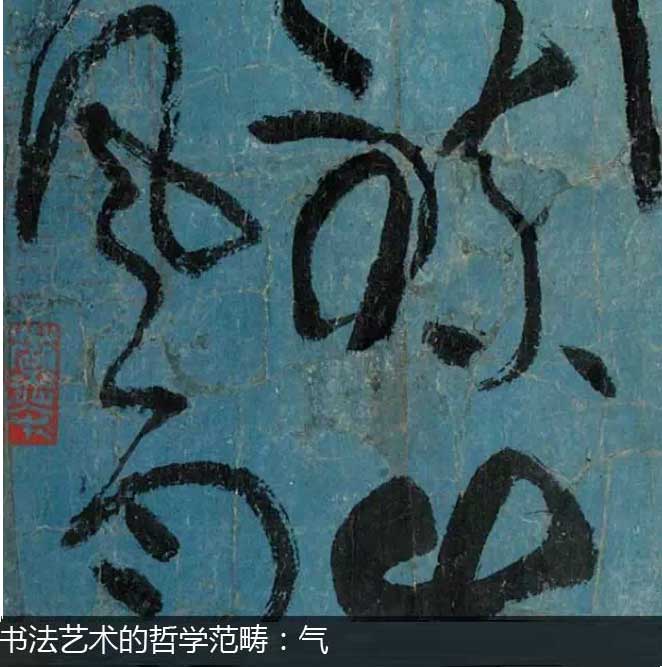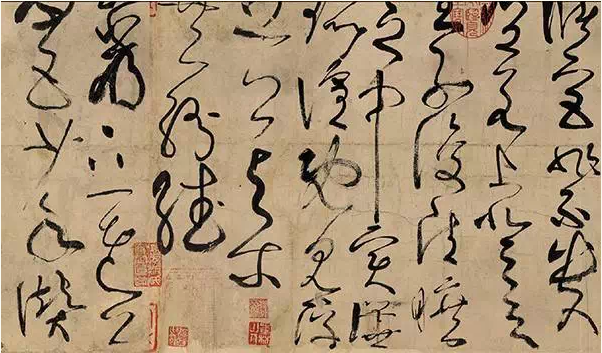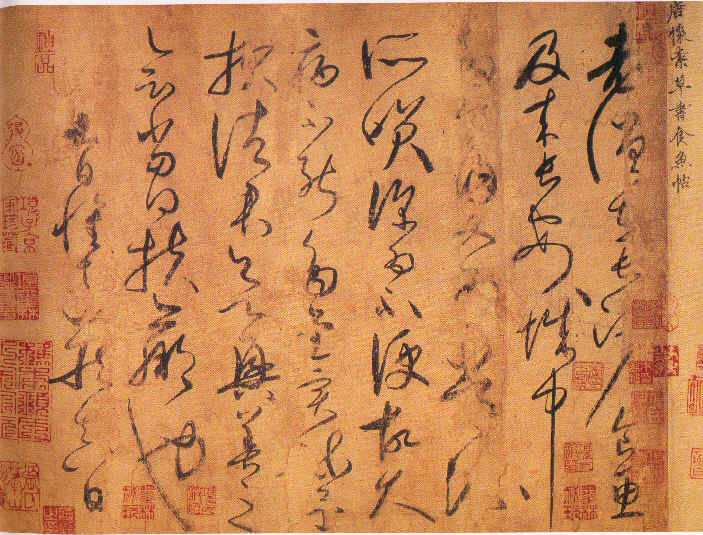
"Qi and rhyme" are often mentioned in both calligraphy creation and calligraphy appreciation. Although this is a virtual realm of metaphysical association, it seems to have nothing to do with calligraphy creation. In fact, it is not the case. Qi is the origin of the aesthetic vitality and creativity of the subject of calligraphy art. . This actually directly involves the creation of calligraphy, the relationship between calligraphy subjects and calligraphy objects, and the understanding of the art of calligraphy.
1. Qi is a very complex and all-encompassing cultural connotation
"Qi" is a philosophical concept with rich connotations and complex content in Chinese cultural thought. The basic category of this philosophy originated from the ancestors’ observation of the natural world and their experience of the ontological movement of human life in ancient times. "The clear air rises and becomes the sky, and the turbid air descends and becomes the earth." "The sky has six qi... The six qi are yin, yang, wind, rain, darkness, and light." ("Zuo Zhuan·Year of Zhaogong") Xu Shen's "Shuowen Jiezi" explains that Qi Yun "Qi, cloud Qi". Around the Western Zhou and Eastern Zhou dynasties, philosophical concepts such as Yin and Yang, the Five Elements, and Six Qi were widely applied and became the main category of human life consciousness, and Qi also became a A philosophical concept with materialistic ideas.
In Chapter 42 of "Laozi" there is: "Tao gives birth to one, gives birth to two, two gives birth to three, and three gives rise to all things. All things bear yin and hold yang, and the energy is in harmony." Zhuangzi's "Zhibeiyou": "The life of man , the accumulation of Qi. When it gathers, it leads to life, and when it disperses, it leads to death." In the Han Dynasty, Dong Zhongshu regarded Qi as the intermediary of "the interaction between heaven and man". Wang Chong further believes that everything in the universe is "born with Qi". Different people's Qi, as well as the thickness and nature of their Qi, will produce different temperaments, characters and thoughts. Since the category of "Qi" is all-encompassing, the concept of Qi can be seen everywhere in ancient Chinese classics. Whether it is nature, social phenomena, human physiology, pathology, or even spiritual morality, thought, religious art, philosophy, etc., they all contain different words and various explanations of Qi. For example: weather, earth qi, mountain and forest qi, cold qi, summer qi, yin qi, yang qi, dry qi, moisture, liver qi, evil qi, righteous qi, menstrual qi, happy qi, angry qi, spiritual qi, delicate qi, gold and stone qi, temple qi, Mountain and wild energy, scholarly energy, husband energy, boudoir energy, village energy, morale, essence energy, strange energy, vitality energy, true energy... The concept of "energy" is further blurred from the image, and gradually forms a pure form of energy without substance. All things are born from Qi, and all things contain Qi. It further demonstrates the aesthetic role of Qi in artistic creation and artistic aesthetics.
2. Qi in the art of calligraphy
In Chinese art aesthetics, Qi is a deep-seated aesthetic with life connotations. It was first seen in "Yue Ji". It is believed that music is produced by the Qi of heaven and earth, and the Qi of musical works is in response to the Qi of the human body. Cao Pi first introduced Qi into literature: "Literature is mainly based on Qi. The clear and turbid Qi has a body, and cannot be overpowered by force." And to..." pioneered the theory of "nourishing qi" in Chinese literature and art and the aesthetic theory of work style; Liu Xie's "The Literary Mind and the Carving of Dragons" is a very important work on the systematic study of the harmony of qi in the history of Chinese aesthetics. In later literary and artistic theories, Qi was mostly introduced into aesthetics. Xie He's "Paintings", Wang Sengqian's "Praise for the Brushwork", and Yu Jianwu's "Books" all put forward the aesthetic ideas of Qi such as charm, taste, and spirit. In calligraphy, there are also many contents such as He Shaoji's idea of integrating nourishing qi and true nature, Liu Xizai's overall aesthetic concept of yin and yang integrating qi.

Qi and calligraphy creation
Qi is the origin of calligraphy creation. "The animal of Qi is the moving thing, so it shakes the temperament and forms various dances and chants." (Zhong Rong's "Poetry") made a clear statement on artistic creation. "Articles express the emotions of all things." (Ye Xie's "Original Poetry") The same is true for calligraphy, which is based on expressing human temperament. "Qi source" and "object image" shake the temperament and form the desire to create. "All images are qi." (Zhang Zai's "Zhengmeng·Qian Sheng") Through object images, people perceive them and transform them into creative impulses, showing the passion during creation. In the "Book Book", there are "five combinations" of creative states: "the mind is happy and leisurely", "the benefits are beneficial to the knowledge", "the time is harmonious and the energy is moist", "paper and ink are in harmony", and "occasionally desire to write". This is the best mental state for calligraphy creation.
There are two realms of calligraphy creation in the true sense:
One is that before the creation of calligraphy, the body's Qi and the invisible Qi of spirit and emotion form complex changes. The Qi transforms into tangible lines through the movement of pen and ink. At the same time, the movement of the lines follows the emotions of the calligraphy subject. There are ups and downs due to changes in the body and the changes in the essence of the whole body. In the process of creation, the different "qi" of emotional impulse and rational thinking constitute the contradiction in the creative process of the main body of calligraphy. This contradiction in turn transforms the metaphysical virtual realm of "qi" into a real realm - tangible Mirror.
The second realm is the highest realm, which is the Taoist realm of "the unity of nature and man" and "the assimilation of things and myself". As Su Dongpo said, "As far as a reed is concerned, the vast expanse of land is at a loss. It is as vast as riding on the wind without knowing where it stops, and fluttering as if leaving the world alone, becoming immortal and ascending to immortality..." Such a state of selflessness... . Creation is a completely natural state of writing.
Among the three ideological pillars of traditional culture: "Yin Yang and Five Elements Theory", "The Theory of Correspondence between Heaven and Man", and "The Thought of Neutral Harmony", the aesthetics of calligraphy takes "nature" as the highest aesthetic realm, so it is also consistent with the "correspondence between nature and man" That is, the relationship between "harmony of nature and man" is the closest. Taoism attaches great importance to Qi. Taoism emphasizes tranquility, breathing and thoughts, and a state of integration with nature. Calligraphy creation emphasizes that the creative subject should be "calm and relaxed", relaxed and calm, reaching a state of selflessness and connected with nature, so that the "vital energy" can be smoothed and the techniques can be better utilized. Therefore, "qi" is not only the essence of life, but also forms the origin of calligraphy creation.
2. Qi in calligraphy works
气是艺术作品生命的本源,它和书法作品的形象——点线有着不可分割的联系,是书法本体所表现的精神状态,是一种由“气”所构成的作品生命的虚境。书法作品缺少了气便成了毛笔汉字的躯壳。如姚鼐所说:“文字者,犹人之言语也,有气以充之,虽百世而后,如立其人而与言于此,无气则积字焉而已。”(《答翁学士书》)唐蔡希宗在《法书论》中说:“每字皆须骨气雄强,爽爽然有飞动之势……”刘熙载在《书概》中也说:“书要兼备阴阳二气,大凡沉着屈郁,阴也;奇拔豪放,阳也。高韵深情,坚质豪气,缺一不可以为书。”可以看出,“气”是书法作品一种生命状态、生机活力的审美。“气”在作品创作与审美中表现为由器质转化为功能,由表象转化为内涵,由形态转化为精神。
具体我们可以从古代书法作品中感受到不同的“气”的存在。
例如:王羲之书真元之气弥漫,不同法帖气又有所不同。《兰亭序》有书卷气、士气、英才气,《姨母帖》、《寒切帖》有古气,《行穰帖》、《大道帖》有超拔气,《得示帖》、《二谢帖》、《孔侍中帖》有冲气、真气、通儒之气,《快雪时晴帖》、《奉橘帖》有平和之气。颜真卿书有丈夫气。《祭侄稿》有悲愤、郁勃之气,《争座位稿》有凛然之气。米芾书法有爽气、豪气、俊杰之气。董其昌书法有清癯之气。赵孟頫、鲜于枢书法有少妇气。宋徽宗瘦金书有闺阁才女之气。《张迁碑》、《礼器碑》有庙堂气。《石门颂》、《杨淮表记》、《论经书》有山野气。《始平公》、《杨大眼》有金石气。王文治书法有粉黛气。弘一法师书法有清静之气。林散之书法有仙风道骨气。等等。碑学有金石气,帖学有书卷气。我们对历代碑帖审美时都会产生不同的气的审美感受。
3.局部的感受
线条:
臃肿的线表现出浊气,劲厉的线表现出爽气,厚重的线表现出篆籀气、拙大之气,疲软的线表现出病气,纤细而飘忽的线表现出柔弱之气,劲直的线表现出霸气,纤柔的线表现出媚气,散锋的线表现出仙气,有力的线表现出元气、冲气,洒脱的线表现出侠气,浮滑的线条表现出习气……
结构:
端庄的结构表现出正气,变化的结构表现出奇气,变形恰当表现出稚气,变形过度则表现出野气,变形无法则为酒气,疏密有致表现出喜悦之气,当疏不疏则表现出郁闷之气,结构舒展表现出清爽之气,结构局促表现出悲哀之气,结构平稳正结表现出和气、仁气,结构奇崛表现出豪气、义气。
墨色:
墨色黑亮表现出精气,墨色淡雅表现出静气,墨色灰暗表现出浊气;淡墨运用恰当表现出灵气,反之则为晦气;浓墨运用恰当则有清刚梗概之气,反之则为村气、俗气;枯墨表现出苍茫之气,涨墨表现出梵气、清气,破墨表现出混沌气;整幅墨色变化表现出生气,墨色单一则生死气。故书法用墨则宜“带燥方润,将浓遂枯”。
书法艺术讲究“形神兼备”,“形”与“神”在艺术中常常相提并论。南齐王僧虔《笔意賛》说“书之妙道,神采为上,形质次之。”元杨维祯说:“故论画之高下着,有传形,有传神。传神者气韵生动是也。”(《图绘宝鉴序》)艺术以写神为上。做到“气韵生动”便谓之传神。
三、书法艺术中的“气韵”
“气”在甲骨文中就有,而“韵”出现较晚,出现在汉魏时期。东汉蔡邕《琴赋》中有“繁弦既抑,雅韵复扬”。繁杂的声音没有了,和谐的音乐便会悦耳动听。曹植在《白鹤赋》中有“聆雅琴之清韵”。许慎《说文解字》:“韵,和也。”“韵”的本义就是音乐和谐的意思。“韵”和“气”其实是一个整体,宗白华认为:“气韵就是宇宙中鼓动万物的‘气’的节奏和谐”。(《中国美学史中重要问题的初步探索》)钱钟书认为“气”为“生气”,“韵”为“远出”,“有余意之谓韵”。唐诗有一首:“君家在何处,妾住在横塘。移船暂且问,或恐是同乡。”便颇有韵味。中国的美学家一般认为“气”是指生命的气势、生气、力度、节奏;“韵”是指和谐、音乐感、余音、余味。在艺术的审美上,气韵和观才更加完整,“气”为阳,“韵”为阴,气韵和观才使阴阳和谐和统一,才合乎“一阴一阳谓之道”,才合乎阴柔美与阳刚美对立统一的艺术审美。
从动静艺术审美上看,“气”是万物动态、动势的生命的活力;“韵”表现为静态、静势的生命的活力。静态、静势并非不动,而是指生命运动的和谐状态。“静者静动,非不动也”。(王夫之《思问录·内篇》)“气韵生动”正是体现了在复杂的矛盾运动中由不平衡到平衡、由不和谐到和谐阴阳、动静统一的艺术审美。毕竟,这种艺术深层的审美是由形象传达出内涵,由实境转换为虚境的艺术审美,所以,就需要在中国传统文化的语境中张开联想的翅膀才能获得。
Qiyun is closely related to momentum, weather, style, meaning, atmosphere, interest, etc. In fact, these aesthetic categories are all born from Qi. Qi Mo is the combined concept of "qi" and "momentum". "Qi" is more internal, and "shi" is more external. They both focus on strength, strength, and power. Cai Yong's "Nine Moments": "The momentum is irresistible, and the momentum is irresistible..." The aesthetics of momentum are widely used in traditional Chinese poetry, calligraphy and painting. For example, Li Bai's poem is evaluated as "the hungry eagle flies down, and the air flows across the sky"; Emperor Wu of Wei's poems are full of domineering power; commenting on Mi Fu's calligraphy as "like a celestial horse taking off its title" and Wang Xizhi's calligraphy as "a dragon leaping over the Tianmen, a tiger crouching on the Phoenix Tower" are all aesthetics of momentum.

In contemporary calligraphy creation, the emphasis on the formal sense of the work and the exhibition hall effect actually emphasize the importance of momentum in calligraphy creation and calligraphy aesthetics. Therefore, calligraphy creation should emphasize the strong and refreshing lines, the momentum of the characters flying, and the grand atmosphere of the work, which is the emphasis on "qi"; the pen should be precise, varied, and rich in artistic language, which is the emphasis on the work. The emphasis on "charm". Only by deeply feeling the charm can we have a profound understanding and improvement of calligraphy creation. There are also He Shaoji’s thoughts on the integration of nourishing qi and true nature, Liu Xizai’s overall aesthetics of yin and yang qi, and many other contents.








